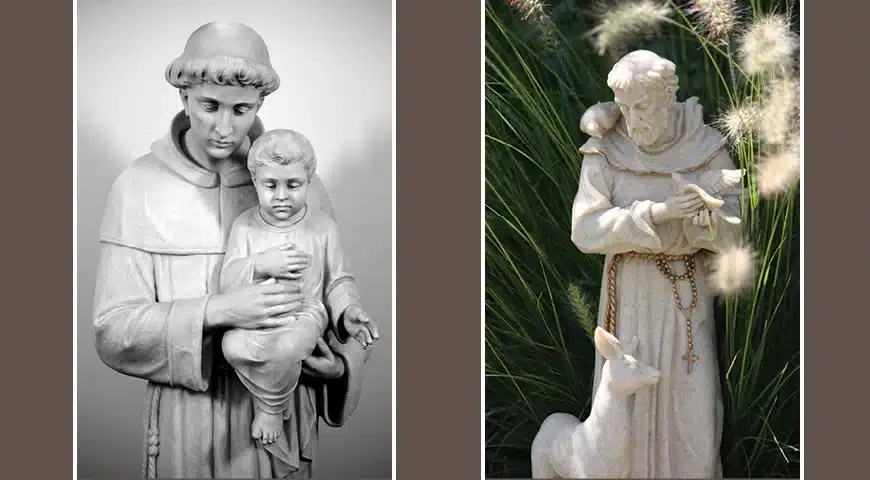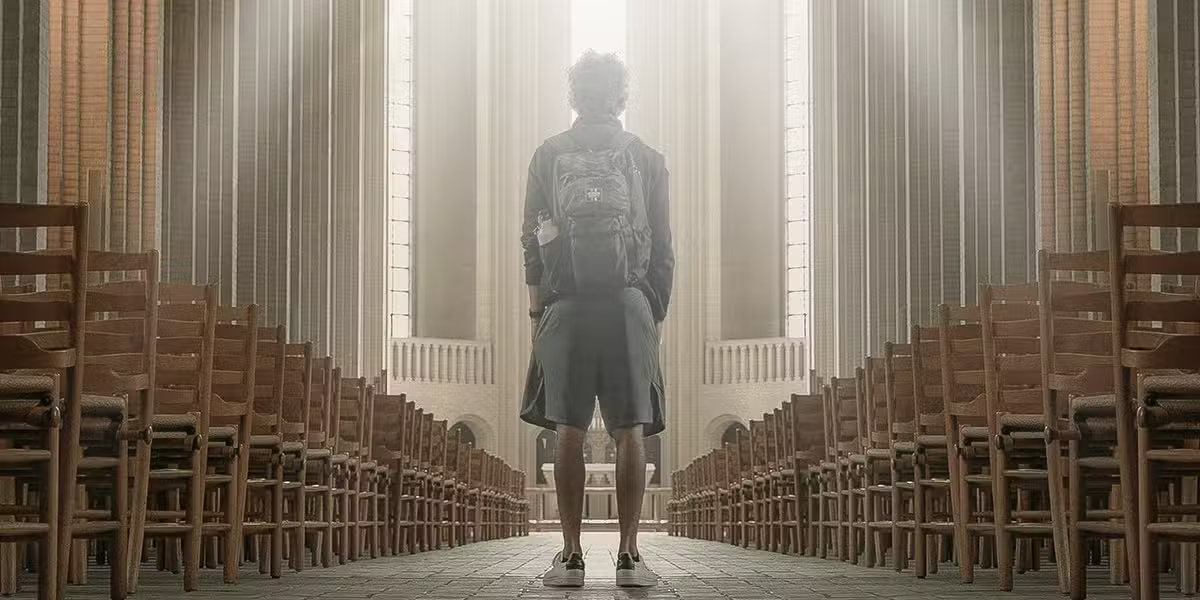One of the more outstanding of St. Francis’ new recruits came from far-off Portugal.
Known to later history as Anthony of Padua, Fernando Martins was born in the early 1190s in Lisbon, a city on the frontiers between Christian and Muslim cultures. His father probably belonged to a family of knights from northern Europe who had come to fight in the Reconquista–the crusade to reclaim the Iberian peninsula from Muslim rule–and had been rewarded with property when Lisbon was “liberated” in 1147.
There Fernando was educated at the cathedral school, apparently destined by his parents for an ecclesiastical career, perhaps the prestigious post of a canon of the cathedral. However, the young Fernando disappointed their hopes by entering a rather austere community of Augustinian canons outside Lisbon.
Distracted by the frequent visits of his family and friends, he asked in 1212 to be transferred to the motherhouse of the congregation, the abbey of Santa Cruz in Coimbra, then the capital of the young kingdom of Portugal. Santa Cruz was the most famous center of religious culture in the country; with a well-stocked library and teachers who had been educated at the great abbey of St. Victor in Paris, it provided excellent resources for the bright young cleric. During Anthony’s years in Coimbra, some Lesser Brothers (Franciscans) arrived in Portugal.
Both the idealism and evangelistic thrust of the new brotherhood appealed to Fernando, who led a virtually cloistered existence in a highly politicized abbey.
His attraction reached a climax when the bodies of Berard and his companions, the five Lesser Brothers who had been executed in Morocco in 1220, were ransomed by King Alfonso and buried as martyrs in the abbey of Santa Cruz. Fernando, fired with a desire to preach the gospel even in the face of death, received permission from his superiors to transfer to the Lesser Brothers, taking the name of the hermitage’s patron, Anthony, as his own.
Almost immediately upon entering the brotherhood, Anthony sought permission from the local minister for permission to go to Africa to preach the gospel among the Muslims. Although his first biographers stress his desire for martyrdom, at least one modern historian has suggested that Anthony, who had grown up in an intercultural city where the Muslim community was very much a living presence, felt that he had a better chance of actually converting Moors rather than antagonizing them, as did the zealous but naive brothers who had been killed in their preaching attempt. However, Anthony fell sick soon after he arrived in Morocco, and then the ship bringing him back was driven off course and landed in Sicily.
Gaining Attention
One of these was Anthony, who was assigned at the same chapter to the Lombard province, which then comprised all of northern Italy. Heretical sects were much more deeply entrenched in that region than in Umbria, so the Minorites often found themselves being asked to distinguish their own message from that of the Cathars and Waldensians.
In this setting, Anthony’s extensive theological training quickly gained him attention, and he soon embarked on an extensive preaching campaign. Before long, he was being urged to instruct other friars in theology so they too would be equipped to explain the Catholic faith. For the Lesser Brothers, such would be a dramatic new move into uncharted waters. Just a few years previously, Francis had learned that the friars in Bologna–hoping to recruit bright young university students as the Dominicans were doing–had accepted a commodious stone house outside the city as a dwelling.
In response, Francis had ordered the brothers to vacate the place, reversing his decision only when Cardinal Ugolino intervened, stating that the house belonged to him. In light of Francis’ feelings, Anthony wanted to make sure he had his support to embark on this new venture. Early in 1224, Francis consented to his request: “It pleases me that you should teach sacred theology to the brothers as long as–in the words of the rule–you ‘do not extinguish the spirit of prayer and devotion with study of this kind.’”
Perhaps one might detect a note of resignation in Francis’ words–on the one hand, he knew the brothers needed to make provision for a rapidly changing situation; on the other he rightly feared that the fostering of study could damage the relationship of the brothers to one another and their commitment to be poor, lesser ones among God’s people. Like power and possessions, knowledge was definitely a temptation to pride and a source of inequality.
Furthermore, serious study required expensive books and more established residences. There is no doubt that during these years Francis was experiencing a certain estrangement from the accelerating developments that were quickly transforming the brothers’ primitive pattern of life. Some of the early sources even refer to a “great temptation” he was experiencing at this time–namely, to give up on his own Order. The Roman curia had rejected the draft of his Rule submitted after the 1221 chapter. He therefore devoted his efforts to composing another, arriving with the help of canonists at a succinct statement of the brotherhood’s basic principles.
This version of the Rule finally gained official confirmation by Honorius III on November 29, 1223, thereby giving his brotherhood definitive legal existence as a religious order in the church… In the summer of 1226, as Francis’ health was deteriorating, he composed “an admonition and exhortation” to his brothers which he called his Testament.
In it, he attempted to recall them to the fundamental inspiration of the movement, reminding the brothers that they were to remain “simple and subject to all.” In that spirit, he urged them not to accept any churches or dwellings unless they were truly appropriate for poor men, nor to seek letters of protection from the papal court. He returned to Assisi, dying at the Portiuncula on the evening of October 3, 1226.
Love for a Saint
On July 16, 1228, only 20 months after his death, Francis of Assisi was proclaimed a saint. The document announcing this event employed militant imagery from the books of Judges to describe Francis as a new fighter on behalf of the church against its enemies… Work on the new basilica (in Assisi), which was the property of the Holy See, progressed at lightning speed; by the time of the next general chapter in 1230, the lower church was essentially completed, and the body of St. Francis was joyfully transferred to its final resting place in a crypt beneath the main altar… Anthony returned to full-time preaching, settling outside Padua, a major papal ally, at the small church of the friars there.
Anthony was asked by the commune to be its official Lenten preacher in 1231; he set up a grueling schedule for himself, preaching daily at various stations throughout the city, hammering home the penitential call for true conversion. In a particular way, he called for achieving a truly Christian society by reconciling feuding political factions and establishing social justice.
At his urging, the commune passed a measure that provided relief for people who had fallen into debt. Exhausted, Anthony retired to a small hermitage outside of town, dying suddenly on June 13.
Anthony’s ascent to sainthood was even more meteoric than Francis’. The citizens of Padua demanded that “their saint” be canonized, and on May 30, 1232, less than a year after his death, Gregory IX announced that this “Hammer of Heretics”–because of Anthony’s profound knowledge of Scripture–was now among the saints of the church.
In so doing, no doubt the pope intended to reward a staunch ally, but also to send a message to the Lesser Brothers. After all, did their Order really deserve a second saint so soon? Dominic had died in 1221, five years before Francis, and had not yet been canonized–that would not happen until 1234. But Gregory wished to point out to the Lesser Brothers at this critical moment of their history that in addition to their founder, they could aspire to another model of holiness.
One could be a devout Lesser Brother and at the same time be a priest serving the pastoral needs of the church. The Franciscans now had two saints, Francis and Anthony, who symbolized two strains that would exist, sometimes in tension, among them from that time forward.









2 thoughts on “Loving Brothers, Beloved Saints: Francis and Anthony”
Lord Jesus Christ, you guide us by the light of your saving truth. Fill our hearts and minds with your light and truth and free us from the blindness of sin and deception that we may see your ways clearly and understand your will for our lives. May we radiate your light and truth to others in word and deed. Amen.
Excellent article about the history of both saints and their overall influence upon the Franciscans and the rest of Christianity. Kinda of amazing that 3 saints all died within 5 years of each other